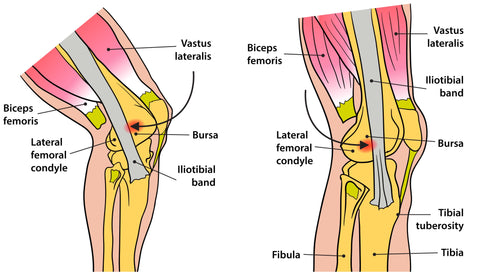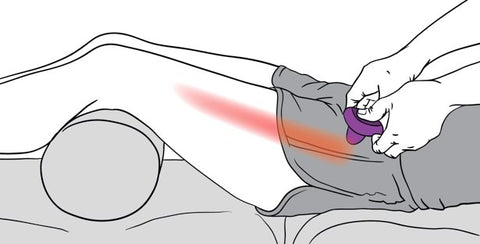Trigger Point Therapy for Iliotibial Band Syndrome (ITBS)
Posted by Stuart Hinds on
Stuart Hinds demonstrates the Ober's Test for assessment and a trigger point therapy treatment sequence for ITBS.
There are no "magic cures" for ITB Syndrome but in most cases, trigger point therapy can have profound effects!
I've been fortunate to have been working with elite athletes for the past 20 years, including the provision of soft tissue support for the Australian Olympic teams at the last four Olympic games.
My colleagues and I have been faced with the need to treat thousands of cases of ITB Syndrome, and whilst there's still much that we don't know about this injury, we have learned through trial and experience, that ITBS can be treated effectively with hands-on protocols.

What is ITB Syndrome?
Iliotibial Band Syndrome has been a source of significant debate when it comes to its aetiology, pathology and treatment.
That is mainly because the iliotibial band itself is an intriguing mystery in sports medicine.
The IT band, as it is commonly called, is the area that runs along the outside our thigh - from above the hip to just below our knee.
The band is made up of fascia, a connective tissue that is elastic in nature and that is found throughout our body.
The IT band, however, is the largest piece of fascia in the human body.
It is still not clear whether the IT band evolved for running or walking but researchers do know that it stores more elastic energy during running than walking.
The basic theory is that it plays an important role in locomotion. As our limbs move, the IT band stretches accordingly.
When we move backwards, energy is stored and as our leg swings forward, the energy is released. The concept is more or less similar to that of recycling energy.
What are the primary symptoms?
The two primary muscles involved in the IT band syndrome are the buttock muscle and the tensor fasciae latae muscles.
That is why the syndrome is also often referred to as the Tensor Fasciae Latae Syndrome, or TFL Syndrome.
The primary symptom of IT band syndrome is a sharp pain in the outer area of the knee. This pain can radiate into the outer thigh or calf.
In some cases, the pain can also spread to the hip.
Most runners experience more pain going downhill and many experience symptoms only during the activities.
However, as the syndrome progresses, it occurs even when they walk.
Preventative Measures
Despite the fact that the IT band syndrome is very common among runners and cyclists, the underlying cause still remains unknown.
However, those who wish to pursue their running career without the complication of the IT band syndrome, there are some very simple preventive measures that can be undertaken.
These include the use of proper and supportive running shoes. Shoes should be changed at regular intervals since running shoes tend to lose half of their shock absorptive capacity after approximately 300 miles.
Thus, wearing the same shoe for too long increases the risk of ITBS and other injuries.
In addition, those who actively run and cycle should do strengthening exercises regularly to avoid IT band syndrome.
Finally, runners should avoid doing too much too soon. The volume of activity should not be increased by more than 5 to 10 percent per week.
If the individual wants to go for a longer run, he should do it at a slower pace so as to avoid the risk of injury.
The type of running surface can also play a role in increasing the likelihood of IT band syndrome.
The important thing to remember is that the earlier the syndrome is diagnosed and treated, the less are the chances of it becoming a chronic condition.
Since the cause of the syndrome remains unclear, runners should ensure they are following basic guidelines to ensure they do not overstretch or overuse the IT band.

Treating trigger points can have profound effects on ITBS
Trigger Point Therapy and ITBS
As with most injuries, there is no miracle cure for ITB Syndrome, and we certainly don't yet know enough about the cause and effect of trigger points.
What we do know is that treating various trigger points in the TFL and gluteus muscles in certain sequences often produces profound effects and may accelerate recovery beyond standard PT or sports massage protocols.
Because ITB Syndrome is so common with athletes (one study found it to be the most common injury of the lower extremity among college athletes who played basketball, field hockey and soccer), numerous techniques have evolved and become established as standard practice.
More often than not, these techniques involve the treatment of trigger points, at the very least as part of a broader treatment program.
|
"Stuart Hinds' online workshops are a learning opportunity not to be missed. You will complete his workshops full of knowledge and the confidence to use your new skills the very next day" Marty Fry, Remedial Massage Therapist |
Courses

Treating Runner's Knee Trigger Point Therapy Masterclass

Soccer Specifics: High-Performance Therapy Online Course
About the author
Stuart Hinds is one of Australia’s leading soft tissue therapists, with over 27 years of experience as a practitioner, working with elite sports athletes, supporting Olympic teams, educating and mentoring others as well as running a highly successful clinic in Geelong.
Stuart has a strong following of practitioners across Australia and globally who tap into his expertise as a soft-tissue specialist. He delivers a range of highly sought after seminars across Australia, supported by online videos, webinars and one-on-one mentoring to help support his colleagues to build successful businesses.
In 2016, Stuart was awarded a lifetime membership to Massage & Myotherapy Australia for his significant support and contribution to the industry.
This trigger point therapy blog is intended to be used for information purposes only and is not intended to be used for medical diagnosis or treatment or to substitute for a medical diagnosis and/or treatment rendered or prescribed by a physician or competent healthcare professional. This information is designed as educational material, but should not be taken as a recommendation for treatment of any particular person or patient. Always consult your physician if you think you need treatment or if you feel unwell.
Liquid error (sections/article-template line 26): Could not find asset snippets/relatedblogs.liquidShare this post
- 0 comment
- Tags: ITBS, Knee, Ober's Test, Trigger Point Therapy
